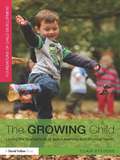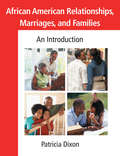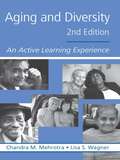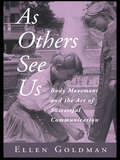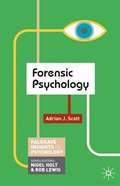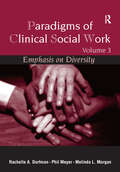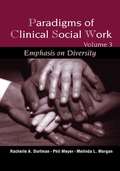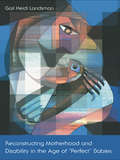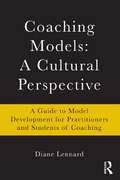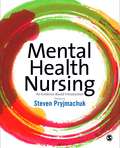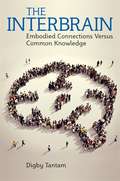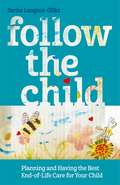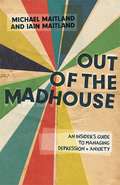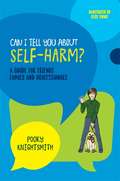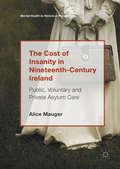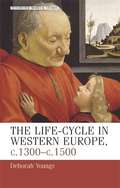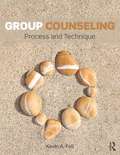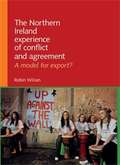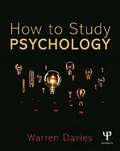- Table View
- List View
The Growing Child: Laying the foundations of active learning and physical health
by Clair StevensHow do children’s early physical experiences influence their future health and well-being? What are the future consequences of a sedentary childhood on life chances and health? What importance do we place in the UK on sleep, fresh air, good nutrition and movement? The Growing Child thoughtfully discusses the key principles of children’s physical development alongside descriptions of everyday practice. It looks in detail at all aspects of physical development including exercise, diet, sleep and how these link to the development of the whole child. The book considers key learning dispositions such as perseverance, determination, confidence, responsibility, courage and curiosity and shows how physical play helps to develop children’s organisational skills, team work, risk management, communication and raise their self-esteem. Drawing on the author’s own experience of running a Forest School nursery, the book aims to help practitioners to: create rich and stimulating play environments that enable children to learn, make connections and explore using their whole bodies; reflect on their own teaching methods to encourage children’s engagement, motivation and creativity through effective observation and planning; engage with parents and carers to help support children’s learning at home whilst maintaining the values of the family; celebrate the uniqueness of each child and provide learning experiences that are appropriate for individuals with particular learning needs, be they physical, emotional or cognitive to ensure that every child has an equal opportunity to succeed. The first seven years of life provide distinct opportunities to lay the foundations for a positive, successful and happy life; it is essential that this is underpinned with a sound knowledge of child development. Emphasising the importance of understanding the theory that underpins children’s physical development, this accessible text shows practitioners how they can use this knowledge to provide learning opportunities that nourish children’s health, learning and well-being.
African American Relationships, Marriages, and Families: An Introduction
by Patricia DixonAfrican American Relationships, Marriages, and Families is a historically and culturally centered text designed for relationship, marriage and family educators and therapists who work with African American singles and couples. Complete with numerous exercises, the book helps singles and couples increase their self-awareness, partner awareness and respect, and appreciation for difference. It also helps foster effective communication and conflict resolution skills, showing readers how to develop and maintain healthy relationships, marriages, and families. No ground is left uncovered in Dixon’s thoughtful and considered analysis.
African American Relationships, Marriages, and Families: An Introduction
by Patricia DixonAfrican American Relationships, Marriages, and Families is a historically and culturally centered text designed for relationship, marriage and family educators and therapists who work with African American singles and couples. Complete with numerous exercises, the book helps singles and couples increase their self-awareness, partner awareness and respect, and appreciation for difference. It also helps foster effective communication and conflict resolution skills, showing readers how to develop and maintain healthy relationships, marriages, and families. No ground is left uncovered in Dixon’s thoughtful and considered analysis.
Aging and Diversity: An Active Learning Experience
by Chandra M. Mehrotra Lisa S. Wagner Stephen FriedThis new edition has been completely rewritten and includes chapters that address key topics in diversity and aging: research methods, psychological aging; health beliefs, behaviors, and services; health disparities; informal and formal care for older persons; work and retirement; religious affiliation and spirituality; and death, dying, and bereavement. Taking a broad view of diversity, Mehrotra and Wagner discuss elements of diversity such as gender, race or ethnicity, religious affiliation, social class, rural-urban community location and sexual orientation. Including these elements allows them to convey some of the rich complexities of our diverse culture - complexities that provide both challenges to meet the needs of diverse population and opportunities to learn how to live in a pluralistic society. Throughout the book, Mehrotra and Wagner present up-to-date knowledge and scholarship in a way that engages readers in active learning. Rather than simply transmitting information, the authors place ongoing emphasis on developing readers’ knowledge and skills; fostering higher order thinking and encouraging exploration of personal values and attitudes. Distinctive features of the book include: Opening vignettes for each chapter that present a sampling of how the issues to be discussed apply to diverse elders. Active learning experiences that invite readers to interview diverse elders, conduct internet searches, and give an analysis of a case study. Quizzes at the end of the chapters help readers ascertain the extent to which they have learned the material; the key for each quiz includes details about correct and incorrect responses so that additional learning can occur. Aging and Diversity Online boxes interspersed throughout the book provide internet resources that readers may use to find new research and publications. Suggested readings and audiovisual resources given at the end of each chapter serve as a guide to additional information on topics covered in the chapter. This approach of presenting the material will help the readers understand and apply key concepts and principles in ways that will not only improve the lives of older people they serve, but will also enhance their own aging experience.
Aging and Diversity: An Active Learning Experience
by Chandra M. Mehrotra Lisa S. Wagner Stephen FriedThis new edition has been completely rewritten and includes chapters that address key topics in diversity and aging: research methods, psychological aging; health beliefs, behaviors, and services; health disparities; informal and formal care for older persons; work and retirement; religious affiliation and spirituality; and death, dying, and bereavement. Taking a broad view of diversity, Mehrotra and Wagner discuss elements of diversity such as gender, race or ethnicity, religious affiliation, social class, rural-urban community location and sexual orientation. Including these elements allows them to convey some of the rich complexities of our diverse culture - complexities that provide both challenges to meet the needs of diverse population and opportunities to learn how to live in a pluralistic society. Throughout the book, Mehrotra and Wagner present up-to-date knowledge and scholarship in a way that engages readers in active learning. Rather than simply transmitting information, the authors place ongoing emphasis on developing readers’ knowledge and skills; fostering higher order thinking and encouraging exploration of personal values and attitudes. Distinctive features of the book include: Opening vignettes for each chapter that present a sampling of how the issues to be discussed apply to diverse elders. Active learning experiences that invite readers to interview diverse elders, conduct internet searches, and give an analysis of a case study. Quizzes at the end of the chapters help readers ascertain the extent to which they have learned the material; the key for each quiz includes details about correct and incorrect responses so that additional learning can occur. Aging and Diversity Online boxes interspersed throughout the book provide internet resources that readers may use to find new research and publications. Suggested readings and audiovisual resources given at the end of each chapter serve as a guide to additional information on topics covered in the chapter. This approach of presenting the material will help the readers understand and apply key concepts and principles in ways that will not only improve the lives of older people they serve, but will also enhance their own aging experience.
As Others See Us: Body Movement and the Art of Successful Communication
by Ellen GoldmanAs Others See Us, first published in 1994 by Gordon & Breach, is a book designed to introduce the reader to a new way of thinking about the movements, both conscious and unconscious, that we make every day and every second of our lives. Goldman describes the human experience as a continuous stream of body movements, though we are only aware of a small fraction of the more obvious and intrusive physical acts. The aim of this book is first to increase awareness of the subtleties and complexities of our body language, and then to encourage the reader to perceive these intricacies in their own movements and in those of others. Finally, with a more complete understanding and appreciation for the power of body language and non-verbal communication, one can achieve a deeper connection between physical and intellectual spheres, to allow for a fuller and more engaging experience of communication and expression. This new knowledge of the human body's movements not only permits one to more accurately perceive the emotions and thoughts of others, but can allow a glimpse into one's own mind, to see how we present ourselves to the world, and whether our thoughts are in sync with our actions. Central to the text is the author's treatment of the Integrated Movement, a term used to describe the merger of a posture and a gesture with a consistent quality, dynamic or shape. This approach to understanding and explaining human movement offers a unique way of thinking about conscious gesture, unconscious body language, and verbal speech as interconnected communication, a synthesis that allows for a more complete view of ourselves and others around us. The structure of the book follows a logical framework that mirrors the progress of the reader, from perception of movement, to the close inspection of gesture and body language, to the introduction and experience of Integrated Movement, to the application of one's new awareness to different aspects of life. Biographical sketches of leading figures in the field are included, as are suggestions for additional reading and resources. Perhaps the most unique feature of the book are the personal exercises (boxed-off text) that appear on almost every other page. These exercises are designed to allow the reader to experience the power of body language in real-life situations, while working towards the increased awareness and perception that is the goal of the book.
Forensic Psychology (PDF)
by Adrian ScottThis introduction shows the reader how much forensic psychology informs us about every step of the criminal process. From biological, social and cognitive theories of crime to eyewitness testimony and the penal system, this is essential reading for students seeking a deeper understanding of the key topics.
Paradigms of Clinical Social Work: Emphasis on Diversity
by Rachelle A. Dorfman-Zukerman Melinda L. Morgan Phil MeyerDesigned to mirror how social work theory and practice is taught, Paradigms of Clinical Social Work, Volume 3 presents new therapeutic models through an imaginary family experiencing common social work problems.
Paradigms of Clinical Social Work: Emphasis on Diversity
by Rachelle A. Dorfman-Zukerman Melinda L. Morgan Phil MeyerDesigned to mirror how social work theory and practice is taught, Paradigms of Clinical Social Work, Volume 3 presents new therapeutic models through an imaginary family experiencing common social work problems.
Reconstructing Motherhood and Disability in the Age of Perfect Babies
by Gail LandsmanExamining mothers of newly diagnosed disabled children within the context of new reproductive technologies and the discourse of choice, this book uses anthropology and disability studies to revise the concept of "normal" and to establish a social environment in which the expression of full lives will prevail.
Coaching Models: for Practitioners and Students of Coaching
by Diane Lennard"In addition to providing an extensive analysis of strategies for changing performance and the factors that can impact coaching effectiveness, this book offers what may be a unique value: instead of promoting one approach as the best, Dr. Lennard guides readers through a highly customized process of developing our own individualized coaching model. As a result of the book's thought-provoking activities, I strengthened my own sense of personal authenticity and saw new ways to coach and collaborate fully with employees who may have very different perspectives." — Tita Theodora Beal, Learning & Development, Pfizer, Inc. "This is a wise book. The essential take-away is simple and profound. Develop, refine, and apply your own (as in ownership) personalized coaching model. Much is provided; nothing is imposed. Readers are invited to reflect on unique and defining experiences, strengths, values, perspectives and style and to begin creating their own ‘work in progress.’ Coaching Models will be a compelling read for experienced coaches and new coach practitioners alike." — Bethene LeMahieu, Ed.D.; Professional Coach and Conversation Conservationist Coaching Models: A Cultural Perspective encourages and assists students and practitioners of business coaching to develop and apply their own coaching models. The entire field of coaching will benefit from having coaches who use their models to continually improve their practice. The first part of this book presents the model development process by looking at the relationship among culture, beliefs, and behavior in the coaching context. It explains the importance of identifying cultural factors that influence the way coaches approach coaching interactions, and their coaching models. The second section provides coaches with information and strategies for developing personalized coaching models, applying them to specific contexts, and reflecting on their interactions to refine their core coaching practices. The third part describes the evolution of the author’s own coaching model—the Performance Coaching Model—and illustrates how one coach incorporates unique perspectives and sets of skills, knowledge, and experience in her coaching practice.
Coaching Models: for Practitioners and Students of Coaching
by Diane Lennard"In addition to providing an extensive analysis of strategies for changing performance and the factors that can impact coaching effectiveness, this book offers what may be a unique value: instead of promoting one approach as the best, Dr. Lennard guides readers through a highly customized process of developing our own individualized coaching model. As a result of the book's thought-provoking activities, I strengthened my own sense of personal authenticity and saw new ways to coach and collaborate fully with employees who may have very different perspectives." — Tita Theodora Beal, Learning & Development, Pfizer, Inc. "This is a wise book. The essential take-away is simple and profound. Develop, refine, and apply your own (as in ownership) personalized coaching model. Much is provided; nothing is imposed. Readers are invited to reflect on unique and defining experiences, strengths, values, perspectives and style and to begin creating their own ‘work in progress.’ Coaching Models will be a compelling read for experienced coaches and new coach practitioners alike." — Bethene LeMahieu, Ed.D.; Professional Coach and Conversation Conservationist Coaching Models: A Cultural Perspective encourages and assists students and practitioners of business coaching to develop and apply their own coaching models. The entire field of coaching will benefit from having coaches who use their models to continually improve their practice. The first part of this book presents the model development process by looking at the relationship among culture, beliefs, and behavior in the coaching context. It explains the importance of identifying cultural factors that influence the way coaches approach coaching interactions, and their coaching models. The second section provides coaches with information and strategies for developing personalized coaching models, applying them to specific contexts, and reflecting on their interactions to refine their core coaching practices. The third part describes the evolution of the author’s own coaching model—the Performance Coaching Model—and illustrates how one coach incorporates unique perspectives and sets of skills, knowledge, and experience in her coaching practice.
Mental Health Nursing: An Evidence Based Introduction
by Professor Steven PryjmachukDo you want to know how to help people with mental health problems? This book introduces you to the core skills and essential knowledge you need to deliver high-quality care. Mental Health Nursing is a practical, values- and evidence-based resource which will guide and support you through your pre-registration mental health nursing programme and into your own practice. Dedicated chapters focus on the major mental health problems, and are clearly structured so that you can quickly and easily identify what you want learn about helping people with, for example, depression, anxiety, psychosis, or acute mental health problems. The most up-to-date theories, as well as mental health policies and law from all four countries of the UK, are explained accessibly by experienced lecturers and nurse practitioners who show you through real-life case scenarios how you can use your newly-acquired knowledge and skills to deliver high-quality care yourself. You will also be encouraged - through regular reflection and discussion points - to see things with a critical eye and to engage in and drive on the debates that make mental health nursing such an exciting field to be studying and working in. Set within a framework which emphasises and makes clear the core skills, values and knowledge-base you need to become capable mental health nurse, you will find this book a vital companion as you progress through your studies and onto helping people confidently in everyday life.
Mental Health Nursing: An Evidence Based Introduction
by Dr Steven PryjmachukDo you want to know how to help people with mental health problems? This book introduces you to the core skills and essential knowledge you need to deliver high-quality care. Mental Health Nursing is a practical, values- and evidence-based resource which will guide and support you through your pre-registration mental health nursing programme and into your own practice. Dedicated chapters focus on the major mental health problems, and are clearly structured so that you can quickly and easily identify what you want learn about helping people with, for example, depression, anxiety, psychosis, or acute mental health problems. The most up-to-date theories, as well as mental health policies and law from all four countries of the UK, are explained accessibly by experienced lecturers and nurse practitioners who show you through real-life case scenarios how you can use your newly-acquired knowledge and skills to deliver high-quality care yourself. You will also be encouraged - through regular reflection and discussion points - to see things with a critical eye and to engage in and drive on the debates that make mental health nursing such an exciting field to be studying and working in. Set within a framework which emphasises and makes clear the core skills, values and knowledge-base you need to become capable mental health nurse, you will find this book a vital companion as you progress through your studies and onto helping people confidently in everyday life.
The Interbrain: Embodied Connections Versus Common Knowledge
by Digby TantamDigby Tantam presents his ground-breaking theory of the interbrain, the idea that human beings are endlessly connected by a continuous interplay of non-verbal communication of which we are unaware. Considering social smiles and the way emotions can spread from one person to another, he explores the research that shows how our brains are linked and draws out the implications of the interbrain for our understanding of empathy, social communication, psychology and group behaviour. Exploring this often overlooked aspect of our human nature, Tantam demonstrates how the interbrain has huge significance for psychology, psychiatry and sociology and can transform our understanding of war, morality, terrorism, psychopathy and much more.
The Interbrain: Embodied Connections Versus Common Knowledge
by Digby TantamDigby Tantam presents his ground-breaking theory of the interbrain, the idea that human beings are endlessly connected by a continuous interplay of non-verbal communication of which we are unaware. Considering social smiles and the way emotions can spread from one person to another, he explores the research that shows how our brains are linked and draws out the implications of the interbrain for our understanding of empathy, social communication, psychology and group behaviour. Exploring this often overlooked aspect of our human nature, Tantam demonstrates how the interbrain has huge significance for psychology, psychiatry and sociology and can transform our understanding of war, morality, terrorism, psychopathy and much more.
Follow the Child: Planning and Having the Best End-of-Life Care for Your Child
by Sacha Langton-GilksDrawing on her family's own experiences and those of other parents facing the death of a child from illness or a life-limiting condition, Sacha Langton-Gilks explains the challenges, planning, and conversations that can be expected during this traumatic period. Practical advice such as how to work with the healthcare professionals, drawing up an Advance Care Plan, and how to move care into the home sit alongside tender observations of how such things worked in her own family's story. The book also includes a template person-centred planning document, developed by experts in the field. Empowering and reassuring, this book will help families plan and ensure the best possible end-of-life care for a child or young person.
Out of the Madhouse: An Insider's Guide to Managing Depression and Anxiety
by Iain Maitland Michael MaitlandOnce upon a time, there lived a happy family called the Maitlands. Iain, the father, was a writer. Tracey, the mother, worked at a nearby school. They had three bright and charming children, Michael, Sophie and Adam. It looked like the perfect family life. Until October 2012, when Iain received a message. Michael had been taken to hospital. Years of depression, anxiety and anorexia had taken their toll, and he had pneumonia and a collapsed lung. The doctors weren't sure if he would make it. Told with humour and frankness through Michael's diary entries and Iain's own reflections, Out of the Madhouse charts Michael's journey to recovery from entering the Priory and returning home, to becoming a mental health ambassador for young people. Sharing tips and techniques that have helped them and others to self-manage, this is an essential resource for anyone experiencing depression, anxiety, OCD and similar issues.
Can I Tell You About Self-Harm?: A Guide for Friends, Family and Professionals
by Pooky Knightsmith Elise Evans Jonathan SingerMeet Asher - a teenager who self-harms to manage their feelings when it all feels like too much. The latest in the best-selling Can I Tell You About... series describes what self-harm is, along with the wide range of behaviours that qualify, why teens do it, and how to get help if you feel the need to self-harm. Reflecting on the different aspects of self-harming behaviour, including treatment of injuries and scars, this concise introduction dispels common myths and offers helpful resources to break the cycle of self-harm. By initiating the conversation around self-harm, this guide will offer alternative avenues for children and young adults to pursue when dealing with big feelings, such as professional counselling, distraction, and friends and family. This easy-to-read guide is suitable for readers 7+, along with their parents, teachers, and friends. All author royalties from the book will go towards the Charlie Waller Memorial Trust.
The Cost of Insanity in Nineteenth-Century Ireland: Public, Voluntary and Private Asylum Care
by Alice MaugerThis open access book is the first comparative study of public, voluntary and private asylums in nineteenth-century Ireland. Examining nine institutions, it explores whether concepts of social class and status and the emergence of a strong middle class informed interactions between gender, religion, identity and insanity. It questions whether medical and lay explanations of mental illness and its causes, and patient experiences, were influenced by these concepts. The strong emphasis on land and its interconnectedness with notions of class identity and respectability in Ireland lends a particularly interesting dimension. The book interrogates the popular notion that relatives were routinely locked away to be deprived of land or inheritance, querying how often “land grabbing” Irish families really abused the asylum system for their personal economic gain. The book will be of interest to scholars of nineteenth-century Ireland and the history of psychiatry and medicine in Britain and Ireland.
The Cost of Insanity in Nineteenth-Century Ireland: Public, Voluntary and Private Asylum Care
by Alice MaugerThis open access book is the first comparative study of public, voluntary and private asylums in nineteenth-century Ireland. Examining nine institutions, it explores whether concepts of social class and status and the emergence of a strong middle class informed interactions between gender, religion, identity and insanity. It questions whether medical and lay explanations of mental illness and its causes, and patient experiences, were influenced by these concepts. The strong emphasis on land and its interconnectedness with notions of class identity and respectability in Ireland lends a particularly interesting dimension. The book interrogates the popular notion that relatives were routinely locked away to be deprived of land or inheritance, querying how often “land grabbing” Irish families really abused the asylum system for their personal economic gain. The book will be of interest to scholars of nineteenth-century Ireland and the history of psychiatry and medicine in Britain and Ireland.
The Life Cycle In Western Europe, C. 1300-c. 1500 (PDF)
by Deborah YoungsThis is the first study to examine the entire life cycle in the Middle Ages. Drawing on a wide range of secondary and primary material, the book explores the timing and experiences of infancy, childhood, adolescence and youth, adulthood, old age and, finally, death. It discusses attitudes towards ageing, rites of passage, age stereotypes in operation, and the means by which age was used as a form of social control, compelling individuals to work, govern, marry and pay taxes. The wide scope of the study allows contrasts and comparisons to be made across gender, social status and geographical location. It considers whether men and women experienced the ageing process in the same way, and examines the differences that can be discerned between northern and southern Europe. The fourteenth and fifteenth centuries suffered famine, warfare, plague and population collapse. This fascinating consideration of the life cycle adds a new dimension to the debate over continuity and change in a period of social and demographic upheaval.
Group Counseling: Process and Technique
by Kevin A. FallThe subtleties of counseling are very difficult to accurately express in written form alone. This is particularly true in the case of group work, where the interpersonal dynamics expand geometrically. A good group counseling textbook, such as the fifth edition of Group Counseling: Concepts and Procedures (2013), can provide a solid foundation, but video demonstrations can illustrate the nuances of the group experience in ways that words alone cannot. To provide just such a video, Kevin A. Fall has filmed a series of segments of a group in which he acts as leader with six participants and demonstrates the stages of a group as it moves from first session through termination. Fall offers regular sections of audio commentary, analysis, and processing on each segment, totaling a 120-minute program. The companion workbook provides additional information to fill in what is not shown on the film and includes exercises, activities, and discussion questions related to each video segment. The video and workbook are designed to work seamlessly with the Berg, Landreth, and Fall text, but they can also be used alongside any other group counseling textbook.
The Northern Ireland Experience of Conflict and Agreement: A Model for Export? (PDF)
by Robin WilsonThe Northern Ireland Experience of Conflict and Agreement presents a salutary warning to the international community against the fashionable view that there is an 'Irish model' which can be exported to cauterise ethnic troubles around the globe. The book draws on extensive archive research in London and Dublin on the 1970s power-sharing experiment, and on interviews with senior officials and political figures from the two capitals - as well as reconciliation practitioners - about the negotiation and chequered implementation of the Belfastagreement. It shows how stereotyped conceptions of the problem as a product of "ancient hatreds", allied to solutions based on Realpolitik, have failed to transform Northern Ireland from a fragile peace, following the exhaustion of protracted paramilitary campaigns, to genuine reconciliation. The book concludes with practical proposals for constitutional reforms which would favour genuine power-sharing-rather than merely sharing power out-and set Northern Ireland on the road to the "normal", civic society its long-suffering residents desire. It will be essential reading not only foracademics and postgraduates interested in ethnic conflict but also for policy-makers who confront it in practice.
How to Study Psychology
by Warren DaviesDo you want to spend less time studying but end up with better grades, and a deeper understanding of the subject? Studying psychology is a skill that can be learned. In this unique and practical 'how to' guide, Warren Davies offers some simple techniques that will enable students to retain information, organise their workload, and be more productive. By applying some simple and easy-to-make changes to your study habits, you will learn how to: Get more work done in less time Use memory techniques to help you breeze through exams Beat procrastination Develop a deep grasp of difficult topics Write excellent essays (including how to avoid the seven most common essay errors) Cut your study time in half Understand the 'results' section of research papers Write a dissertation to publishable standard. This book is written specifically with psychology undergraduate students in mind, and as such will enhance your learning and improve your grades with techniques that actually work.
